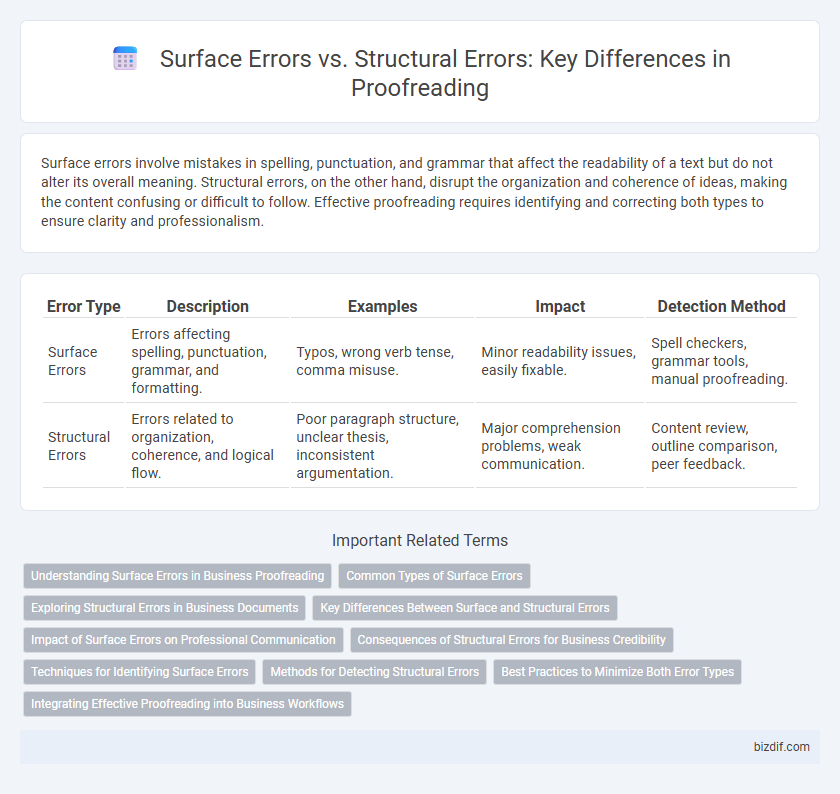Surface errors involve mistakes in spelling, punctuation, and grammar that affect the readability of a text but do not alter its overall meaning. Structural errors, on the other hand, disrupt the organization and coherence of ideas, making the content confusing or difficult to follow. Effective proofreading requires identifying and correcting both types to ensure clarity and professionalism.
Table of Comparison
| Error Type | Description | Examples | Impact | Detection Method |
|---|---|---|---|---|
| Surface Errors | Errors affecting spelling, punctuation, grammar, and formatting. | Typos, wrong verb tense, comma misuse. | Minor readability issues, easily fixable. | Spell checkers, grammar tools, manual proofreading. |
| Structural Errors | Errors related to organization, coherence, and logical flow. | Poor paragraph structure, unclear thesis, inconsistent argumentation. | Major comprehension problems, weak communication. | Content review, outline comparison, peer feedback. |
Understanding Surface Errors in Business Proofreading
Surface errors in business proofreading include typos, spelling mistakes, punctuation errors, and formatting inconsistencies that can undermine professionalism and credibility. These errors distract readers and reduce the clarity of business documents, impacting communication effectiveness. Identifying and correcting surface errors ensures polished presentations and maintains the organization's reputation.
Common Types of Surface Errors
Common types of surface errors in proofreading include spelling mistakes, punctuation errors, and typographical inconsistencies. These errors primarily affect the readability and clarity of the text but do not alter its overall meaning or structure. Identifying and correcting surface errors ensures polished communication and maintains the professionalism of the document.
Exploring Structural Errors in Business Documents
Structural errors in business documents undermine clarity by disrupting the logical flow and coherence between sections, often caused by poor organization or inconsistent formatting. These errors include misaligned headings, inadequate paragraph transitions, and unclear hierarchical relationships within content. Correcting structural errors enhances readability, ensures professional presentation, and supports effective communication in corporate environments.
Key Differences Between Surface and Structural Errors
Surface errors involve minor mistakes such as spelling, punctuation, and grammar that affect the clarity and readability of a text without altering its overall meaning. Structural errors impact the organization and coherence of ideas, including issues with sentence structure, paragraph flow, and logical progression. Identifying surface errors ensures text accuracy, while addressing structural errors enhances the effectiveness and comprehension of the content.
Impact of Surface Errors on Professional Communication
Surface errors, such as spelling mistakes, punctuation errors, and typographical slips, significantly undermine the clarity and professionalism of written communication, leading to misinterpretations and a negative impression of the author's attention to detail. These errors can distract the reader, disrupt the flow of information, and reduce the overall credibility of business reports, emails, and proposals. Minimizing surface errors through rigorous proofreading enhances the effectiveness of professional communication by ensuring messages are polished, precise, and easily understood.
Consequences of Structural Errors for Business Credibility
Structural errors in business documents undermine the overall coherence and clarity, leading to misinterpretations and damaging professional reputation. Such errors can cause clients and stakeholders to question the reliability and competence of the business, potentially resulting in lost opportunities and reduced trust. Ensuring structural accuracy is crucial for maintaining business credibility and fostering positive stakeholder relationships.
Techniques for Identifying Surface Errors
Techniques for identifying surface errors include meticulous line-by-line reading, automated spell checkers, and grammar correction tools. These methods catch typos, punctuation mistakes, and formatting inconsistencies that disrupt text clarity. Highlighting repeated word misuse and homophone confusion further enhances the accuracy of surface error detection.
Methods for Detecting Structural Errors
Methods for detecting structural errors in proofreading include mapping sentence components to ensure proper syntax and using parsing algorithms to analyze grammatical structure. Advanced tools like natural language processing (NLP) software identify inconsistencies in sentence organization and coherence, highlighting issues beyond surface-level typos. Manual techniques involve reverse outlining and sentence diagramming to reveal flawed logic and structural flaws that automated systems might miss.
Best Practices to Minimize Both Error Types
Surface errors, such as spelling, punctuation, and grammar mistakes, require meticulous proofreading with tools like spell checkers and style guides to ensure clarity and accuracy. Structural errors, including improper sentence construction and paragraph organization, demand a comprehensive review of coherence and logical flow by leveraging outlines and peer feedback. Combining automated proofreading software with manual review and iterative revisions significantly reduces both surface and structural errors for polished, professional writing.
Integrating Effective Proofreading into Business Workflows
Surface errors, such as typos and punctuation mistakes, can undermine professionalism and confuse clients, making their swift identification essential in business communications. Structural errors, including awkward sentence flow and illogical organization, impact message clarity and should be addressed through systematic proofreading strategies integrated into workflow processes. Incorporating tools like automated grammar checkers alongside human review ensures comprehensive error detection, enhancing overall document quality and reinforcing brand credibility.
Surface Errors vs Structural Errors Infographic

 bizdif.com
bizdif.com